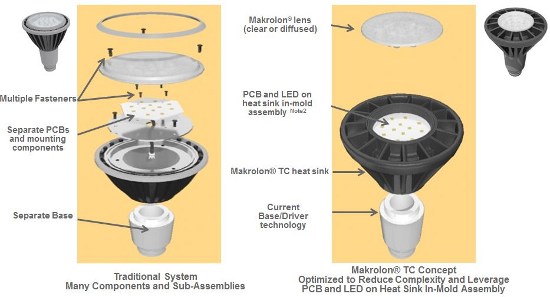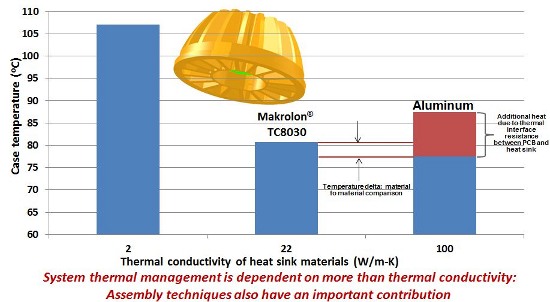 |
| August 28, 2012 | Volume 08 Issue 32 |
Designfax weekly eMagazine
Archives
Partners
Manufacturing Center
Product Spotlight
Modern Applications News
Metalworking Ideas For
Today's Job Shops
Tooling and Production
Strategies for large
metalworking plants
LED Materials:
Polycarbonate stays cool in a hot market
By Kevin Dunay, Market Segment Leader, Electrical/Electronics (EE) Polycarbonates, Bayer MaterialScience LLC

A functional PAR30 demonstration lamp with a heat sink molded from Bayer's new Makrolon TC8030 and a lens molded from Makrolon LED2643.
The light emitting diode (LED) market is heating up. LEDs will account for nearly $95 billion in revenue by 2020, according to McKinsey and Company estimates. This growth will be sparked in part by LEDs' promise to improve energy efficiency compared with incandescent light bulbs, which are being phased out in the U.S., European Union, and Japan.
Yet, while market demand for LEDs is white hot, overheating is a significant obstacle for lighting designers and manufacturers to overcome as LED technology goes mainstream.
When an LED reaches a high temperature, its color attributes change, the lumen output decreases, and its lifetime shortens. A heat sink is critical to the performance of an LED by helping to dissipate heat. Aluminum has been a popular material to use in heat sinks, but it comes with disadvantages:
- Weight: Aluminum has up to a 90% higher density level than a plastic material.
- Appearance: Sensitive to damp environments, aluminum is prone to corrosion, necessitating additional preventive measures to reduce this damage.
- Thermal performance: Aluminum is highly thermally conductive but requires the use of a thermal interface material, which can cause an increase in temperature that will likely affect LED performance.
Bayer MaterialScience LLC recently launched a new grade of thermally conductive plastic to help lighting manufacturers overcome limitations of other materials and meet consumer demand quickly and cost effectively.

Figure 1. Bayer MaterialScience LLC offers several Makrolon polycarbonate grades for use in light emitting diodes (LED) lighting that can improve part modularity.
The new grade, Makrolon TC8030 polycarbonate, joins a selection of heat-resistant Bayer plastics developed for LED applications (see Figure1). It is targeted for use in LED heat sinks for replacement lamps and next-generation luminaires. Compared with aluminum, this grade of Makrolon offers lower density and enhanced design freedom. This material can also provide cost saving by eliminating assembly steps, improving production efficiency, and reducing capital investment. Because Makrolon TC8030 plastic is injection molded, it can provide improved thermal management compared to aluminum by reducing the thermal interface (see Figure 2).

Figure 2.
The material has a UL 94 flame class rating of V-0 at 2.0 mm. It is currently available in a black color. Additional colors can be achieved through secondary operations, such as film insert molding or painting.
With many popular consumer products experiencing overheating issues that affect product life, designers can look to thermally conductive plastics, such as Makrolon TC8030, to help keep products cool as markets heat up.
As manufacturers' and designers' needs evolve, scientists at Bayer will continue to develop new solutions that will help them stay in front of market trends.
Find out more about all grades of Bayer MaterialScience Makrolon here.
Published August 2012
Rate this article
View our terms of use and privacy policy
